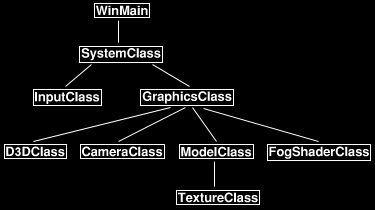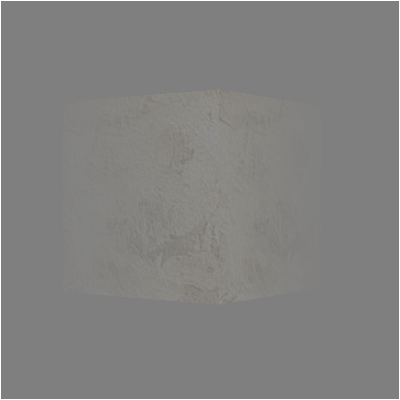DirectX 10 教程23:雾
原文地址:Tutorial 23: Fog(http://www.rastertek.com/dx10tut23.html)。
源代码下载:dx10tut23.zip。
本教程介绍如何实现雾,代码基于上一个教程。
我要介绍的雾化效果非常简单。第一步是选择雾的颜色,然后将后备缓存清除为这个颜色,现在整个场景都被雾化。然后对雾中的每个对象,在像素着色器中基于对象的距离添加一定量的雾化颜色。我们可以使用不同的雾化方程,本教程使用的是线性雾化方程。
雾化方程
线性雾化基于对象离开相机的距离添加一个线性变化的雾:
Linear Fog = (FogEnd - ViewpointDistance) / (FogEnd - FogStart)
指数雾添加一个按指数函数变化的雾:
Exponential Fog = 1.0 / 2.71828 power (ViewpointDistance * FogDensity)
指数平方雾添加一个比上一个方程更加稠密的雾:
Exponential Fog 2 = 1.0 / 2.71828 power ((ViewpointDistance * FogDensity) * (ViewpointDistance * FogDensity))
以上方程都会生成一个雾化因子,我们使用以下方程将雾化因子施加到模型的纹理上生成最终的颜色:
Fog Color = FogFactor * TextureColor + (1.0 - FogFactor) * FogColor
本教程我们会在顶点着色器中生成雾化因子,在像素着色器中计算最终的颜色。
框架
框架中新添了FogShaderClass用于处理雾的绘制,这个类基于TextureShaderClass稍加修改。

首先看一下fog HLSL shader的dau代码:
Fog.fx
//////////////////////////////////////////////////////////////////////////////// // Filename: fog.fx //////////////////////////////////////////////////////////////////////////////// ///////////// // GLOBALS // ///////////// matrix worldMatrix; matrix viewMatrix; matrix projectionMatrix; Texture2D shaderTexture;
新添了两个变量表示雾化开始和结束的距离。
float fogStart;
float fogEnd;
///////////////////
// SAMPLE STATES //
///////////////////
SamplerState SampleType
{
Filter = MIN_MAG_MIP_LINEAR;
AddressU = Wrap;
AddressV = Wrap;
};
//////////////
// TYPEDEFS //
//////////////
struct VertexInputType
{
float4 position : POSITION;
float2 tex : TEXCOORD0;
};
PixelInputType新添了一个雾化因数变量,这个因子在顶点着色器中计算并发送到像素着色器。
struct PixelInputType
{
float4 position : SV_POSITION;
float2 tex : TEXCOORD0;
float fogFactor : FOG;
};
////////////////////////////////////////////////////////////////////////////////
// Vertex Shader
////////////////////////////////////////////////////////////////////////////////
PixelInputType FogVertexShader(VertexInputType input)
{
PixelInputType output;
float4 cameraPosition;
// Change the position vector to be 4 units for proper matrix calculations.
input.position.w = 1.0f;
// Calculate the position of the vertex against the world, view, and projection matrices.
output.position = mul(input.position, worldMatrix);
output.position = mul(output.position, viewMatrix);
output.position = mul(output.position, projectionMatrix);
// Store the texture coordinates for the pixel shader.
output.tex = input.tex;
首先计算顶点在视空间中的Z坐标,然后使用这个坐标和雾化开始和结束距离生成雾化因子。
// Calculate the camera position.
cameraPosition = mul(input.position, worldMatrix);
cameraPosition = mul(cameraPosition, viewMatrix);
// Calculate linear fog.
output.fogFactor = saturate((fogEnd - cameraPosition.z) / (fogEnd - fogStart));
return output;
}
////////////////////////////////////////////////////////////////////////////////
// Pixel Shader
////////////////////////////////////////////////////////////////////////////////
float4 FogPixelShader(PixelInputType input) : SV_Target
{
float4 textureColor;
float4 fogColor;
float4 finalColor;
// Sample the texture pixel at this location.
textureColor = shaderTexture.Sample(SampleType, input.tex);
// Set the color of the fog to grey.
fogColor = float4(0.5f, 0.5f, 0.5f, 1.0f);
然后对纹理颜色和雾化颜色基于雾化因子进行线性插值。
// Calculate the final color using the fog effect equation.
finalColor = input.fogFactor * textureColor + (1.0 - input.fogFactor) * fogColor;
return finalColor;
}
////////////////////////////////////////////////////////////////////////////////
// Technique
////////////////////////////////////////////////////////////////////////////////
technique10 FogTechnique
{
pass pass0
{
SetVertexShader(CompileShader(vs_4_0, FogVertexShader()));
SetPixelShader(CompileShader(ps_4_0, FogPixelShader()));
SetGeometryShader(NULL);
}
}
Fogshaderclass.h
FogShaderClass与TextureShaderClass大致相同,只不过多了实现雾化的代码。
////////////////////////////////////////////////////////////////////////////////
// Filename: fogshaderclass.h
////////////////////////////////////////////////////////////////////////////////
#ifndef _FOGSHADERCLASS_H_
#define _FOGSHADERCLASS_H_
//////////////
// INCLUDES //
//////////////
#include <d3d10.h>
#include <d3dx10.h>
#include <fstream>
using namespace std;
////////////////////////////////////////////////////////////////////////////////
// Class name: FogShaderClass
////////////////////////////////////////////////////////////////////////////////
class FogShaderClass
{
public:
FogShaderClass();
FogShaderClass(const FogShaderClass&);
~FogShaderClass();
bool Initialize(ID3D10Device*, HWND);
void Shutdown();
void Render(ID3D10Device*, int, D3DXMATRIX, D3DXMATRIX, D3DXMATRIX, ID3D10ShaderResourceView*, float, float);
private:
bool InitializeShader(ID3D10Device*, HWND, WCHAR*);
void ShutdownShader();
void OutputShaderErrorMessage(ID3D10Blob*, HWND, WCHAR*);
void SetShaderParameters(D3DXMATRIX, D3DXMATRIX, D3DXMATRIX, ID3D10ShaderResourceView*, float, float);
void RenderShader(ID3D10Device*, int);
private:
ID3D10Effect* m_effect;
ID3D10EffectTechnique* m_technique;
ID3D10InputLayout* m_layout;
ID3D10EffectMatrixVariable* m_worldMatrixPtr;
ID3D10EffectMatrixVariable* m_viewMatrixPtr;
ID3D10EffectMatrixVariable* m_projectionMatrixPtr;
ID3D10EffectShaderResourceVariable* m_texturePtr;
新添了两个指针表示shader中的雾化开始和结束距离。
ID3D10EffectScalarVariable* fogStartPtr; ID3D10EffectScalarVariable* fogEndPtr; }; #endif
Fogshaderclass.cpp
////////////////////////////////////////////////////////////////////////////////
// Filename: fogshaderclass.cpp
////////////////////////////////////////////////////////////////////////////////
#include "fogshaderclass.h"
FogShaderClass::FogShaderClass()
{
m_effect = 0;
m_technique = 0;
m_layout = 0;
m_worldMatrixPtr = 0;
m_viewMatrixPtr = 0;
m_projectionMatrixPtr = 0;
m_texturePtr = 0;
在构造函数中将表示雾化开始和结束距离的指针初始化为null。
fogStartPtr = 0;
fogEndPtr = 0;
}
FogShaderClass::FogShaderClass(const FogShaderClass& other)
{
}
FogShaderClass::~FogShaderClass()
{
}
bool FogShaderClass::Initialize(ID3D10Device* device, HWND hwnd)
{
bool result;
加载fog.fx HLSL shader文件。
// Initialize the shader that will be used to draw the triangles.
result = InitializeShader(device, hwnd, L"../Engine/fog.fx");
if(!result)
{
return false;
}
return true;
}
void FogShaderClass::Shutdown()
{
// Shutdown the shader effect.
ShutdownShader();
return;
}
Render方法新添了代表雾化开始和结束距离的参数,在此方法中首先设置这些参数,然后调用shader进行绘制。
void FogShaderClass::Render(ID3D10Device* device, int indexCount, D3DXMATRIX worldMatrix, D3DXMATRIX viewMatrix,
D3DXMATRIX projectionMatrix, ID3D10ShaderResourceView* texture, float fogStart, float fogEnd)
{
// Set the shader parameters that it will use for rendering.
SetShaderParameters(worldMatrix, viewMatrix, projectionMatrix, texture, fogStart, fogEnd);
// Now render the prepared buffers with the shader.
RenderShader(device, indexCount);
return;
}
bool FogShaderClass::InitializeShader(ID3D10Device* device, HWND hwnd, WCHAR* filename)
{
HRESULT result;
ID3D10Blob* errorMessage;
D3D10_INPUT_ELEMENT_DESC polygonLayout[2];
unsigned int numElements;
D3D10_PASS_DESC passDesc;
// Initialize the error message.
errorMessage = 0;
// Load the shader in from the file.
result = D3DX10CreateEffectFromFile(filename, NULL, NULL, "fx_4_0", D3D10_SHADER_ENABLE_STRICTNESS, 0,
device, NULL, NULL, &m_effect, &errorMessage, NULL);
if(FAILED(result))
{
// If the shader failed to compile it should have writen something to the error message.
if(errorMessage)
{
OutputShaderErrorMessage(errorMessage, hwnd, filename);
}
// If there was nothing in the error message then it simply could not find the shader file itself.
else
{
MessageBox(hwnd, filename, L"Missing Shader File", MB_OK);
}
return false;
}
Technique的名称修改为FogTechnique。
// Get a pointer to the technique inside the shader.
m_technique = m_effect->GetTechniqueByName("FogTechnique");
if(!m_technique)
{
return false;
}
// Now setup the layout of the data that goes into the shader.
// This setup needs to match the VertexType stucture in the ModelClass and in the shader.
polygonLayout[0].SemanticName = "POSITION";
polygonLayout[0].SemanticIndex = 0;
polygonLayout[0].Format = DXGI_FORMAT_R32G32B32_FLOAT;
polygonLayout[0].InputSlot = 0;
polygonLayout[0].AlignedByteOffset = 0;
polygonLayout[0].InputSlotClass = D3D10_INPUT_PER_VERTEX_DATA;
polygonLayout[0].InstanceDataStepRate = 0;
polygonLayout[1].SemanticName = "TEXCOORD";
polygonLayout[1].SemanticIndex = 0;
polygonLayout[1].Format = DXGI_FORMAT_R32G32_FLOAT;
polygonLayout[1].InputSlot = 0;
polygonLayout[1].AlignedByteOffset = D3D10_APPEND_ALIGNED_ELEMENT;
polygonLayout[1].InputSlotClass = D3D10_INPUT_PER_VERTEX_DATA;
polygonLayout[1].InstanceDataStepRate = 0;
// Get a count of the elements in the layout.
numElements = sizeof(polygonLayout) / sizeof(polygonLayout[0]);
// Get the description of the first pass described in the shader technique.
m_technique->GetPassByIndex(0)->GetDesc(&passDesc);
// Create the input layout.
result = device->CreateInputLayout(polygonLayout, numElements, passDesc.pIAInputSignature, passDesc.IAInputSignatureSize,
&m_layout);
if(FAILED(result))
{
return false;
}
// Get pointers to the three matrices inside the shader so we can update them from this class.
m_worldMatrixPtr = m_effect->GetVariableByName("worldMatrix")->AsMatrix();
m_viewMatrixPtr = m_effect->GetVariableByName("viewMatrix")->AsMatrix();
m_projectionMatrixPtr = m_effect->GetVariableByName("projectionMatrix")->AsMatrix();
// Get pointer to the texture resource inside the shader.
m_texturePtr = m_effect->GetVariableByName("shaderTexture")->AsShaderResource();
获取shader中的fog start和end指针。
// Get pointers to the fog start and end variables inside the shader.
fogStartPtr = m_effect->GetVariableByName("fogStart")->AsScalar();
fogEndPtr = m_effect->GetVariableByName("fogEnd")->AsScalar();
return true;
}
void FogShaderClass::ShutdownShader()
{
在ShutdownShader中释放两个新添的指针。
// Release the pointers to the fog variables inside the shader.
fogStartPtr = 0;
fogEndPtr = 0;
// Release the pointer to the texture in the shader file.
m_texturePtr = 0;
// Release the pointers to the matrices inside the shader.
m_worldMatrixPtr = 0;
m_viewMatrixPtr = 0;
m_projectionMatrixPtr = 0;
// Release the pointer to the shader layout.
if(m_layout)
{
m_layout->Release();
m_layout = 0;
}
// Release the pointer to the shader technique.
m_technique = 0;
// Release the pointer to the shader.
if(m_effect)
{
m_effect->Release();
m_effect = 0;
}
return;
}
void FogShaderClass::OutputShaderErrorMessage(ID3D10Blob* errorMessage, HWND hwnd, WCHAR* shaderFilename)
{
char* compileErrors;
unsigned long bufferSize, i;
ofstream fout;
// Get a pointer to the error message text buffer.
compileErrors = (char*)(errorMessage->GetBufferPointer());
// Get the length of the message.
bufferSize = errorMessage->GetBufferSize();
// Open a file to write the error message to.
fout.open("shader-error.txt");
// Write out the error message.
for(i=0; i<bufferSize; i++)
{
fout << compileErrors[i];
}
// Close the file.
fout.close();
// Release the error message.
errorMessage->Release();
errorMessage = 0;
// Pop a message up on the screen to notify the user to check the text file for compile errors.
MessageBox(hwnd, L"Error compiling shader. Check shader-error.txt for message.", shaderFilename, MB_OK);
return;
}
void FogShaderClass::SetShaderParameters(D3DXMATRIX worldMatrix, D3DXMATRIX viewMatrix, D3DXMATRIX projectionMatrix,
ID3D10ShaderResourceView* texture, float fogStart, float fogEnd)
{
// Set the world matrix variable inside the shader.
m_worldMatrixPtr->SetMatrix((float*)&worldMatrix);
// Set the view matrix variable inside the shader.
m_viewMatrixPtr->SetMatrix((float*)&viewMatrix);
// Set the projection matrix variable inside the shader.
m_projectionMatrixPtr->SetMatrix((float*)&projectionMatrix);
// Bind the texture.
m_texturePtr->SetResource(texture);
设置fog start和fog end的值。
// Set the start point for the fog effect inside the shader.
fogStartPtr->SetFloat(fogStart);
// Set the end point for the fog effect inside the shader.
fogEndPtr->SetFloat(fogEnd);
return;
}
void FogShaderClass::RenderShader(ID3D10Device* device, int indexCount)
{
D3D10_TECHNIQUE_DESC techniqueDesc;
unsigned int i;
// Set the input layout.
device->IASetInputLayout(m_layout);
// Get the description structure of the technique from inside the shader so it can be used for rendering.
m_technique->GetDesc(&techniqueDesc);
// Go through each pass in the technique (should be just one currently) and render the triangles.
for(i=0; i<techniqueDesc.Passes; ++i)
{
m_technique->GetPassByIndex(i)->Apply(0);
device->DrawIndexed(indexCount, 0, 0);
}
return;
}
Graphicsclass.h
//////////////////////////////////////////////////////////////////////////////// // Filename: graphicsclass.h //////////////////////////////////////////////////////////////////////////////// #ifndef _GRAPHICSCLASS_H_ #define _GRAPHICSCLASS_H_ ///////////// // GLOBALS // ///////////// const bool FULL_SCREEN = true; const bool VSYNC_ENABLED = true; const float SCREEN_DEPTH = 1000.0f; const float SCREEN_NEAR = 0.1f; /////////////////////// // MY CLASS INCLUDES // /////////////////////// #include "d3dclass.h" #include "cameraclass.h" #include "modelclass.h"
新添了FogShaderClass头文件。
#include "fogshaderclass.h"
////////////////////////////////////////////////////////////////////////////////
// Class name: GraphicsClass
////////////////////////////////////////////////////////////////////////////////
class GraphicsClass
{
public:
GraphicsClass();
GraphicsClass(const GraphicsClass&);
~GraphicsClass();
bool Initialize(int, int, HWND);
void Shutdown();
bool Frame();
bool Render();
private:
D3DClass* m_D3D;
CameraClass* m_Camera;
ModelClass* m_Model;
创建了FogShaderClass对象。
FogShaderClass* m_FogShader; }; #endif
Graphicsclass.cpp
下面的代码只包含与上一个教程不同的部分。
////////////////////////////////////////////////////////////////////////////////
// Filename: graphicsclass.cpp
////////////////////////////////////////////////////////////////////////////////
#include "graphicsclass.h"
GraphicsClass::GraphicsClass()
{
m_D3D = 0;
m_Camera = 0;
m_Model = 0;
在构造函数中初始化FogShaderClass对象。
m_FogShader = 0;
}
GraphicsClass::GraphicsClass(const GraphicsClass& other)
{
}
GraphicsClass::~GraphicsClass()
{
}
bool GraphicsClass::Initialize(int screenWidth, int screenHeight, HWND hwnd)
{
bool result;
// Create the Direct3D object.
m_D3D = new D3DClass;
if(!m_D3D)
{
return false;
}
// Initialize the Direct3D object.
result = m_D3D->Initialize(screenWidth, screenHeight, VSYNC_ENABLED, hwnd, FULL_SCREEN, SCREEN_DEPTH, SCREEN_NEAR);
if(!result)
{
MessageBox(hwnd, L"Could not initialize Direct3D.", L"Error", MB_OK);
return false;
}
// Create the camera object.
m_Camera = new CameraClass;
if(!m_Camera)
{
return false;
}
// Create the model object.
m_Model = new ModelClass;
if(!m_Model)
{
return false;
}
// Initialize the model object.
result = m_Model->Initialize(m_D3D->GetDevice(), L"../Engine/data/seafloor.dds", "../Engine/data/cube.txt");
if(!result)
{
MessageBox(hwnd, L"Could not initialize the model object.", L"Error", MB_OK);
return false;
}
创建并初始化FogShaderClass对象。
// Create the fog shader object.
m_FogShader = new FogShaderClass;
if(!m_FogShader)
{
return false;
}
// Initialize the fog shader object.
result = m_FogShader->Initialize(m_D3D->GetDevice(), hwnd);
if(!result)
{
MessageBox(hwnd, L"Could not initialize the fog shader object.", L"Error", MB_OK);
return false;
}
return true;
}
void GraphicsClass::Shutdown()
{
在Shutdown方法中释放FogShaderClass对象。
// Release the fog shader object.
if(m_FogShader)
{
m_FogShader->Shutdown();
delete m_FogShader;
m_FogShader = 0;
}
// Release the model object.
if(m_Model)
{
m_Model->Shutdown();
delete m_Model;
m_Model = 0;
}
// Release the camera object.
if(m_Camera)
{
delete m_Camera;
m_Camera = 0;
}
// Release the Direct3D object.
if(m_D3D)
{
m_D3D->Shutdown();
delete m_D3D;
m_D3D = 0;
}
return;
}
bool GraphicsClass::Frame()
{
// Set the position of the camera.
m_Camera->SetPosition(0.0f, 0.0f, -10.0f);
return true;
}
bool GraphicsClass::Render()
{
float fogColor, fogStart, fogEnd;
D3DXMATRIX worldMatrix, viewMatrix, projectionMatrix;
static float rotation = 0.0f;
首先设置雾化参数。
// Set the color of the fog to grey. fogColor = 0.5f; // Set the start and end of the fog. fogStart = 0.0f; fogEnd = 10.0f;
将后备缓存清除为雾的颜色,这对雾的效果来说是非常重要的步骤。
// Clear the scene to the color of the fog.
m_D3D->BeginScene(fogColor, fogColor, fogColor, 1.0f);
// Generate the view matrix based on the camera's position.
m_Camera->Render();
// Get the world, view, and projection matrices from the camera and d3d objects.
m_D3D->GetWorldMatrix(worldMatrix);
m_Camera->GetViewMatrix(viewMatrix);
m_D3D->GetProjectionMatrix(projectionMatrix);
// Update the rotation variable each frame.
rotation += (float)D3DX_PI * 0.005f;
if(rotation > 360.0f)
{
rotation -= 360.0f;
}
D3DXMatrixRotationY(&worldMatrix, rotation);
// Put the model vertex and index buffers on the graphics pipeline to prepare them for drawing.
m_Model->Render(m_D3D->GetDevice());
// Render the model using the fog shader.
m_FogShader->Render(m_D3D->GetDevice(), m_Model->GetIndexCount(), worldMatrix, viewMatrix, projectionMatrix,
m_Model->GetTexture(), fogStart, fogEnd);
// Present the rendered scene to the screen.
m_D3D->EndScene();
return true;
}
总结
我们介绍了如何实现一个基本的线性雾化效果,如果你想尝试其他雾化方程,最好是用在一个广大的场景中,有一些树木的地形就很合适。

练习
1.编译并运行程序,你会看到雾中有一个旋转的立方体,按escape键退出。
2.修改雾化开始和结束的值。
3.将后备缓存清除为黑色而不是雾的颜色,观察效果的不同。
4.实现其他两种雾化方程。
文件下载(已下载 1459 次)发布时间:2012/8/11 下午3:33:00 阅读次数:7540
